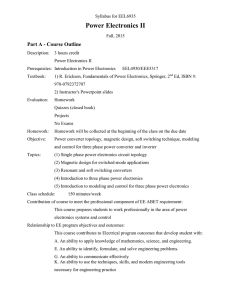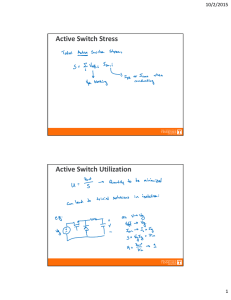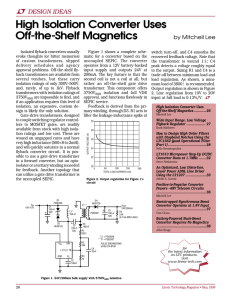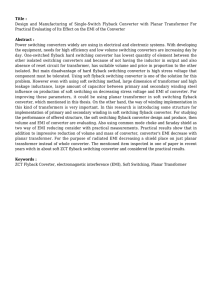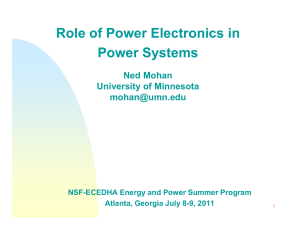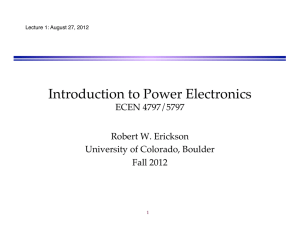Power Electronic Systems
advertisement
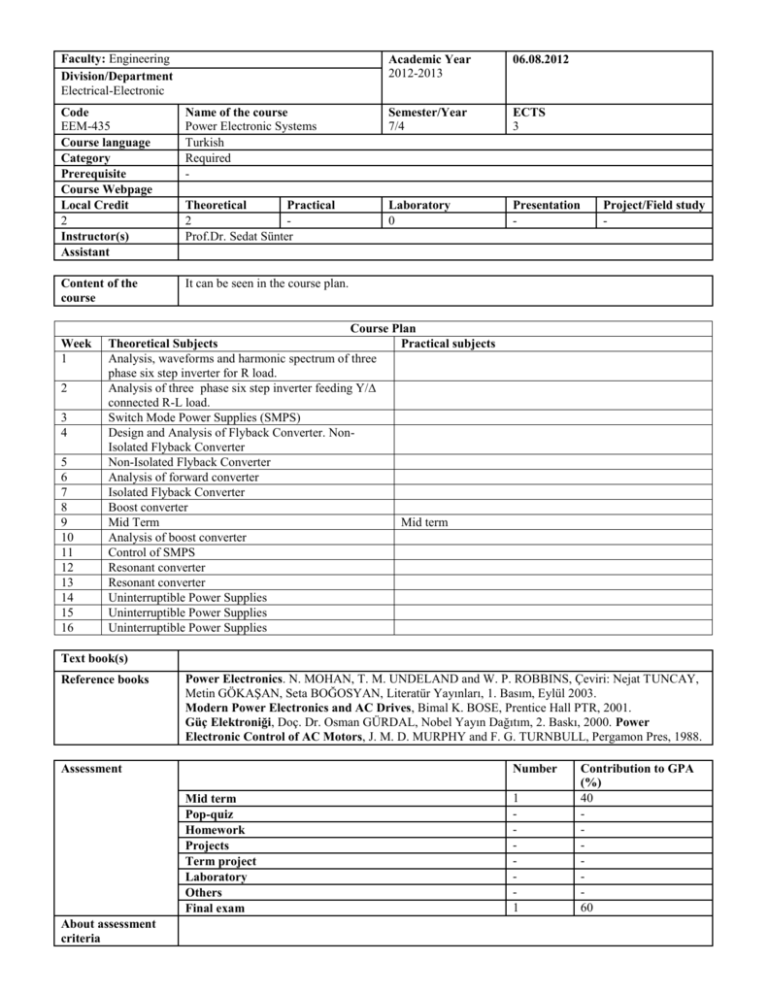
Faculty: Engineering Division/Department Electrical-Electronic Academic Year 2012-2013 06.08.2012 Code EEM-435 Course language Category Prerequisite Course Webpage Local Credit 2 Instructor(s) Assistant Name of the course Power Electronic Systems Turkish Required - Semester/Year 7/4 ECTS 3 Theoretical Practical 2 Prof.Dr. Sedat Sünter Laboratory 0 Presentation - Content of the course It can be seen in the course plan. Week 1 2 3 4 5 6 7 8 9 10 11 12 13 14 15 16 Project/Field study - Course Plan Theoretical Subjects Practical subjects Analysis, waveforms and harmonic spectrum of three phase six step inverter for R load. Analysis of three phase six step inverter feeding Y/∆ connected R-L load. Switch Mode Power Supplies (SMPS) Design and Analysis of Flyback Converter. NonIsolated Flyback Converter Non-Isolated Flyback Converter Analysis of forward converter Isolated Flyback Converter Boost converter Mid Term Mid term Analysis of boost converter Control of SMPS Resonant converter Resonant converter Uninterruptible Power Supplies Uninterruptible Power Supplies Uninterruptible Power Supplies Text book(s) Reference books Power Electronics. N. MOHAN, T. M. UNDELAND and W. P. ROBBINS, Çeviri: Nejat TUNCAY, Metin GÖKAŞAN, Seta BOĞOSYAN, Literatür Yayınları, 1. Basım, Eylül 2003. Modern Power Electronics and AC Drives, Bimal K. BOSE, Prentice Hall PTR, 2001. Güç Elektroniği, Doç. Dr. Osman GÜRDAL, Nobel Yayın Dağıtım, 2. Baskı, 2000. Power Electronic Control of AC Motors, J. M. D. MURPHY and F. G. TURNBULL, Pergamon Pres, 1988. Assessment Number Mid term Pop-quiz Homework Projects Term project Laboratory Others Final exam About assessment criteria 1 1 Contribution to GPA (%) 40 60 Contribution of the contents (%) Medical Sciences Engineering General Sciences Social sciences Learning Outcomes They will gain application ability of mathematics, science and engineering knowledge which have been learnt in the other courses such as power electronic, engineering mathematic, etc. The students will be describing, modelling, formulating and solving engineering problems. The module is actually a continuance of power electronics module and it is aimed to analyse and design the power electronic systems by implementing the ideas and concepts gained in the module of power electronics. The course will be taught in the classroom using blackboard. Goals Course Format 1 2 3 4 5 6 7 8 9 10 11 12 100 - Relation between the learning and program outcomes Outputs 0 1 2 Having sufficient background in basic mathematics and sciences and basic X engineering; ability to use conceptual and practical knowledge together in this area for engineering solutions. Ability to identify, formulate, and solve electrical electronics X engineering problems,to select and apply appropriate methods and techniques for this purpose. Ability to design a system, component or process to meet the specific X needs and requirements, ability to apply modern methods in this direction Ability to choose modern techniques and equipments that are necessary for X electrical electronics engineering applications, to have an ability to use package programs effectively. Ability to make an experiment, experiment design, analysis of experiment X results and to reach a solution by interpretation in the subjects of electrical electronics engineering and basic engineering. Ability to have access to information and make resource investigation X according to this aim, have an ability for using information resources Ability to work effectively as an individual and in multi-disciplinary teams, X self-reliance in taking responsibility. Ability to communicate and express himself effectively in X Turkish and English, ability to self- confidence and occupational competence to defend their ideas in front of the community on a given subject. Awareness of the necessity of lifelong learning, ability to X followdevelopments in science and technology and self-renewal ability Professional and ethical awareness in engineering approaches. X Awareness about workplace practices, ability to produce engineering X solutions sensitive to human and nature. Having knowledge about education and problems about the age for X understanding the effects of engineering solutions and applications on universal and social dimensions Contribution : 0:None 1:Partially 2:Completely Prepared by: Sedat Sünter Date of preparation: 06.08.2012
